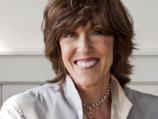The Most of Nora Ephron
Review
The Most of Nora Ephron
Her friend, the editor Robert Gottlieb, says it well in his introduction: Nora Ephron, who died last year at age 71, was “a reporter, a profilist, a polemicist, a novelist, a screenwriter, a playwright, a memoirist, and a (wicked) blogger.” She was also a good cook, apparently, and the writer-director of some of the more charming romantic comedies of the past 20 years. The nice thing about books such as THE MOST OF NORA EPHRON, a 550-page collection of her writing, is that they serve two purposes. They’re candy for people who like the author, and they’re a good introduction for the uninitiated. Fans as well as those unfamiliar with Ephron’s work will find much to enjoy here.
The book is divided into nine categories, each one devoted either to subjects Ephron wrote about or the many literary forms for which she became famous. As she tells us in “Journalism: A Love Story,” Beverly Hills native Ephron began her career in 1962 when, having just received a degree in political science from Wellesley, she got a job in Newsweek’s mailroom. She soon worked her way up (if up is the right word) to clipper, in which she “ripped up the country’s newspapers and routed the clips to the relevant departments,” and then to researcher, which she says was a fancy term for a fact-checker. She eventually went on to write for other publications, including Esquire and New York magazines and the New York Post, the last of which had offices so dirty that someone once wrote “Philthy” in the thick dust that had collected on a window.
"[Ephron] developed a unique, engaging voice, and developed it early in her career --- a remarkable achievement. Readers who like their humor heavily seasoned with sarcasm will love this book."
In her two decades as a journalist, Ephron perfected the hilariously caustic style that would make her famous. In “The Palm Beach Social Pictorial,” an Esquire piece from 1975, she tells us about a periodical written by and for the wealthy women of Palm Beach, Florida. The cover story of one issue was about Mignon Roscher Gardner, a “prominent artist-aviatrix” whose most recent work, a painting “of a naked young man on a flying black horse,” was inspired by Gardner’s desire “to combine her love for horses and for flying.” Of Dorothy Schiff, the “skittishly feminine” owner of the New York Post, Ephron writes, “[I]t seems never to have crossed her mind that she might have a public obligation to produce a good newspaper.” In a 1973 piece on Julie Nixon Eisenhower, Ephron muses that besotted journalists who buy Julie’s honeyed words about her father “have been around Nixon so long that they don’t recognize a chocolate-covered spider when they see one.”
The middle section of the book contains three of Ephron’s longer works. First is HEARTBURN, the recipe-filled novel she wrote about her brief, post-Watergate marriage to Carl Bernstein. The narrator of the novel, Rachel Samstat, is a successful cookbook writer who, seven months’ pregnant, discovers that her journalist husband is having an affair. The second work is Get Lucky, a surprisingly earthy (and sketchy) play produced on Broadway earlier this year. Tom Hanks played Mike McAlary, the reporter for the now-defunct Newsday who in the 1980s broke the story of corrupt police officers in New York’s 77th Precinct. The third work is the screenplay for When Harry Met Sally…, the Woody Allen-esque romantic comedy starring Billy Crystal and Meg Ryan.
Among the more delightful pieces in this collection are Ephron’s essays on food, in which she condemns the egg-white omelette and grass-fed beef, praises the greatest hot pastrami sandwich she had ever eaten, and chronicles the gossip and “internecine struggles” among the Big Four of the 1960s Food Establishment: Craig Claiborne, Michael Field, James Beard and Julia Child.
Ephron had a tendency to generalize whenever she wrote about relationships. “The truth is that men don’t want to be friends with women,” she writes in the afterword to When Harry Met Sally… One assumes she was referring to straight men, but, in any event, she might have been pleased to learn that her premise is not universally correct. Aside from this, however, Ephron’s writing is a treat, always perceptive and funny. Her voice is consistent: But for the topical references, you’d never be able to tell whether a piece was written in 1968 or 2010. She developed a unique, engaging voice, and developed it early in her career --- a remarkable achievement. Readers who like their humor heavily seasoned with sarcasm will love this book.
Reviewed by Michael Magras on November 1, 2013
The Most of Nora Ephron
- Publication Date: October 29, 2013
- Genres: Essays, Fiction, Humor, Nonfiction
- Hardcover: 576 pages
- Publisher: Knopf
- ISBN-10: 038535083X
- ISBN-13: 9780385350839










